Fenn Mako XT S - Review
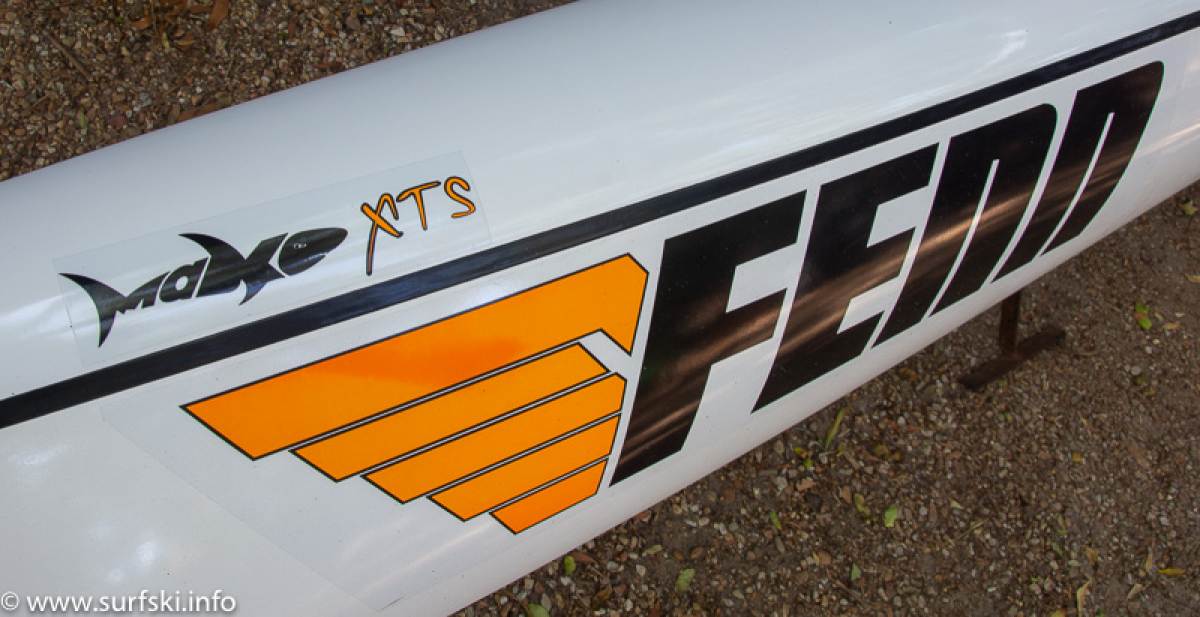 The Fenn Mako XT S is the latest incarnation of the best-selling Fenn Mako XT
The Fenn Mako XT S is the latest incarnation of the best-selling Fenn Mako XT
My opposition surged past me on the last lap of the Seadog race in Fish Hoek. In desperation, I steered to hook onto his side wash… To my surprise the XT S accelerated instantly, and I sat there with little effort riding the wash for the rest of the leg.
Ok, so the XT has always been a craft designed for paddlers of the less-well-balanced variety (I’m not going to say “beginners”) and you wouldn’t expect it to be as fast as the Elite level surfskis.
But if I were looking for a ski, and my priority was “stability before ability”, to quote a certain well-known paddling personality, I’d definitely include the new model Fenn Mako XT S (to give it its formal pedigree name!) in my list of skis to try.
And although I’d be prepared to sacrifice some speed for stability, I’d still have certain criteria by which I’d try to judge the boat before buying it.
Review Point of View
Who am I? For the purposes of the review:
- I’m a relatively experienced paddler, but I’m getting older and I’m looking for a more stable boat.
- I’m a relatively inexperienced paddler on my way up from my very first ski which is, for the sake of argument, a Fenn Blue-fin.
- In either case, I love downwind paddling.
- In either case, I know I’m not going to shoot the lights out racing but I do want to take part in my local round-the-cans Friday night summer series.
Downwind Criteria
- Shouldn’t be prone to broaching. The original XT was notorious; the rudder was placed far back on the hull, it would pop out of the water and the ski would slew off course.
- Should catch runs easily.
- Shouldn’t nose-dive.
- Shouldn’t be too wet (i.e. shouldn’t flood the cockpit too readily)
- Should track straight (i.e. shouldn’t wander off course)
- It should be stable enough that on a downwind paddle I can focus on paddling and catching runs without bracing to stay in the boat.
Nice-to-haves would include:
- Good drainage
- Comfortable cut-out at the back of the seat so that you can lean back when going down runs.
- Comfortable seat
Flat water criteria
- Shouldn’t be so slow that it’s embarrassing. I don’t want to feel that I’m at a disadvantage on flat water relative to the other stable surfskis.
Nice-to-haves:
- The boat should turn reasonably sharply.
General Must-haves
- It should be easy to remount. As a “less-stable” paddler, I don’t want any self-doubts about my ability to get back on the boat.
First Looks
The venerable Fenn Mako XT was one of the first truly stable surfskis, designed for non-elite paddlers on the market.
In this long-awaited update,
- The hull hasn’t changed.
- The nose has been slimmed down, so there’s less volume up front.
- The rudder has been moved forward.
- The seat has been moved forward.
- The overall length is the same.
Dimensions are:
- Length: 580cm
- Beam: 49cm (seam to seam at the widest point)
- Seat width: 40cm

The nose on the XT S has a new, slimmer shape

The XT S has the new Fenn seat shape, with a low hump and leash anchor point
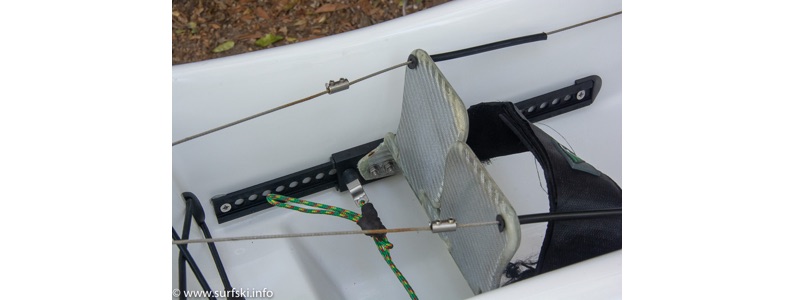
The review boat had the conventional Fenn footplate assembly, but a self adjusting rudder/cable setup is available
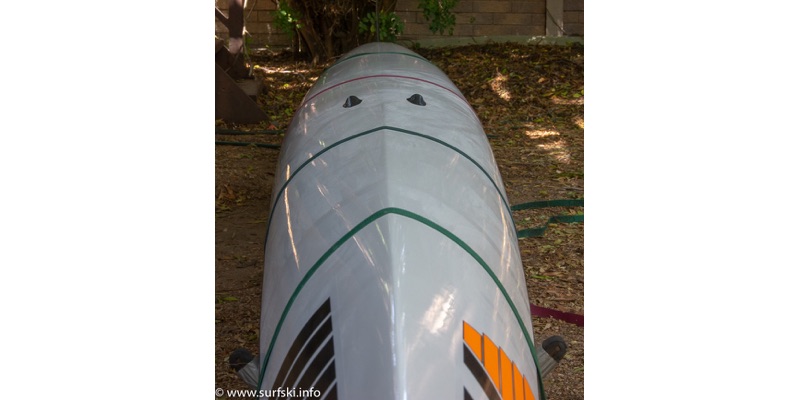
The XT S hull shape hasn't changed from the previous version
Weight
The boat that I trialed was the heaviest, toughest layup: vacuum-bagged fiberglass with polyester resin. The website specifies 18kg for this layup, but the demo boat weighed in at just under 16kg and I confirmed with Fenn Kayaks that 16kg is indeed the target weight for the XT S in glass/polyester resin layup.
The rudder cables were rigged in the conventional way, adjustment requiring a small Allen key. Fenn Kayaks do provide self-adjusting footplates/rudder cables as an option.
All Fenn boats come with a leash anchor point.
The quality of the finish is good; the hull on this boat was rock-hard.
.
First Paddle - Miller’s Run
My first paddle in the boat was a classic Miller’s Run. The conditions included a brisk 22-27kt southeaster that had kicked up some good-sized chop. As usual, the sea was confused for the few km, waves running in several directions, but it straightened up towards the lighthouse and it became easier to ride the runs.
My overall impressions weren’t great: I found the seat excruciating and ended up with a large raw patch on my coccyx. Worse, the steering was sluggish; the boat didn’t feel responsive to the rudder, slewed easily off course and I broached a couple of times to my intense frustration.
On the other hand, my paddling buddy had started just ahead of me and I ended up beating him to the beach and I took that as a good sign.
Any Miller’s Run below 50min we consider acceptable – and I did 49:51.
But I really didn’t enjoy the paddle and was faced with living with a discomfited bum for the next few days.
Tweaking the Boat
I added a bum pad in an effort to make the seat more comfortable. In fairness to Fenn, I should add that I apparently have a particularly boney backside; the XT S has been used by two other paddlers while I’ve had it and both had no complaints about the seat!
Orka Paddles in Cape Town provided me with one of their big elliptical rudders to replace the standard Fenn-supplied item.
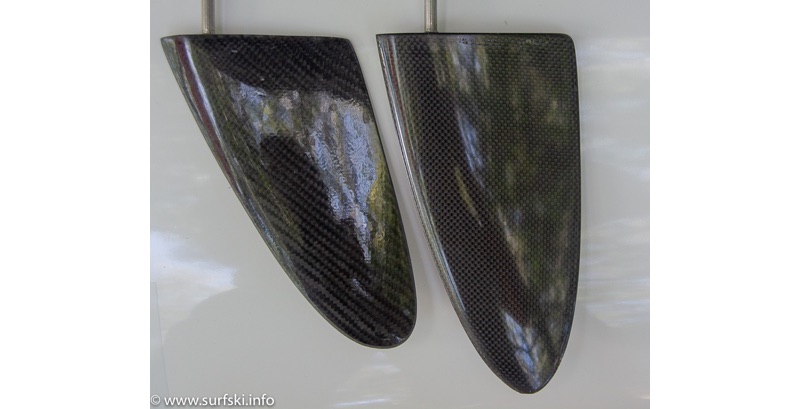
The elliptical rudder makes a perceptible improvement to the handling of the Fenn Mako XT S
(Standard Fenn rudder to the left)
Reverse Miller’s Run
An out-of-season northwester arrived, and the Miller’s Run taxi was operating – just in the opposite direction to normal. (This is one of the reasons that Cape Town is such a downwind mecca; 90% of the time the wind is blowing either southeast or northwest and the downwind conditions are fun either way.)
Bizarrely – we hardly ever get proper swell in False Bay – a long set of about ten big dumpers arrived just as my buddy and I left the beach and we sat there popping over one foamy after another before we finally got the break we needed to sprint out to the backline.
The run was a classic “reverse”: flat water giving way to small chop, with the first ridable runs a couple of km in and finally clean, fun, linkable runs for the last 5km from the lighthouse to Miller’s Point.
The bum pad wasn’t quite in the right place and I was still in some pain – but the surfski tracked (i.e. kept a straight line) better and responded better to steering.
My buddy on this occasion normally beats me quite handily and as soon as we got into the bigger runs, he put the hammer down and pulled away from me – as usual.
But I could maneuver the boat, it didn’t nose-dive, and I had a ball.
A Hectic Miller’s Run
Next up, a few days later, I took the XT S on a much bigger, bouncier Miller’s Run, this time accompanied by a couple of buddies who were paddling: a Swordfish, a Swordfish S and an Elite.
Conditions
The wind was blowing 20-27kt at Fish Hoek – not outrageous, but enough to make it a “good” run – and a fair-sized swell was wrapping into the bay.
But sometimes the wind blows at such an angle that it rebounds off the mountains and for the first 2-3km it gusts side-on, directly offshore. This was one of those days, and every time I caught a run, I couldn’t see a thing as the spray blew straight into my face.
Half way to the Roman Rock lighthouse, the wind straightened up – but the waves were still wild, sets moving in all directions, making it difficult to link sequences of runs.
Easy to catch runs
I noticed however that the XT S seems to catch runs very readily; although the confused chop prevented me from making many long sequences, it was easy to catch run after run and I ended up beating all three of my companions to the beach.
The XT S is perceptibly more stable than the Swordfish S – and that helped too in that I could make the necessary power strokes to accelerate onto the runs without being compromised by any feeling of instability.
As I came into the beach, a monster wave picked up behind me; on the video there’s a muffled “bloody hell!” as the back of the ski rose… but never fear, she tracked straight, and I had a great ride into the sand.
So far so good – the XT S ticks all the boxes as far as downwind is concerned – but how would it feel on the flat, especially in a flat race?
(And although my backside wasn’t raw, it still felt bruised! I still hadn’t cracked the position of the bum pad.)
Seadog Race
Next up was Fish Hoek’s favorite Friday evening activity: the “never cancelled” Seadog Race.
And conditions were flat. A light northwester was blowing offshore, and the 5-lap course would be an honest grind. A number of my marks were paddling, and it would be obvious if the stable hull were a real disadvantage.
I ended up more or less in my usual position in the results coming in 19th overall out of 47 skis.
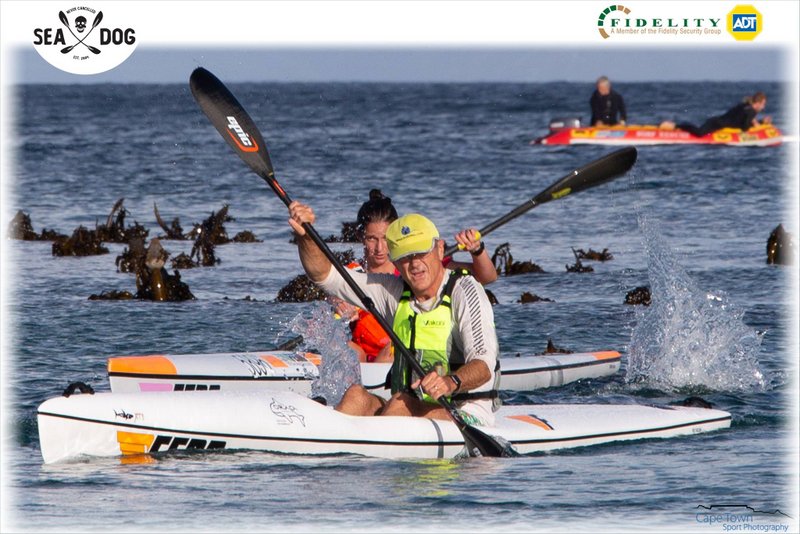
Flat conditions at the Seadog Race in Fish Hoek, Cape Town
My impressions:
- I found it very easy to ride slip on surfskis around me; on one leg, a stronger paddler came steaming past on a Swordfish S, but I was able to hop on his side-slip and together we dropped the group.
- On the “downwind” legs, the ski seemed to accelerate onto the tiny waves.
- But I found it difficult to accelerate when trying to catch the someone ahead of me, as though the drag on the hull increases rapidly limiting my top speed (but hey, as I kept reminding myself, this wasn’t designed to be the fastest boat on the planet.)
- With the bum pad higher up the back of the seat, the pain in my butt wasn’t nearly as severe!
Mellow Miller’s
My final paddle in the boat was a Miller’s run in much more benign conditions: 18-22kt with small, clean runs.
Impressions:
- The boat picks up runs really well.
- Although it’s not as nimble as the Swordfish, the big rudder keeps it straight (enough) and gives it sufficient maneuverability to create sequences.
- If you lean back and keep the nose up, you can extend the glide, and, choosing carefully, you can sometimes bounce the next wave. If you choose badly, it comes to a dead stop... (Again, all boats will wallow if you apply poor technique, but it’s more difficult to power over the XT S over the next wave than the Swordfish, for example.)
- No real propensity to broach (although, just like any other boat, if you’re moving too slowly when a wave arrives, of course you’ll slew off course).
I finished 2min ahead of my buddy; about the usual distance. I’m not sure that I’d have been much further ahead if I’d been on the Swordfish – and I really can’t say that I was at all frustrated by the boat.
Matching the Criteria
So, how does the Fenn XT S shape up in terms of the criteria that I listed?
Downwind
- I didn’t like the handling of the boat with the standard rudder; I felt that the steering was very insensitive. However, when fitted with a bigger elliptical rudder, I found the steering more effective – but without sacrificing any stability (sometimes a bigger rudder can make a boat feel less stable.) The bigger rudder improved the tracking too.
- I was able to accelerate easily onto both big and small waves. Although some water came into the cockpit, it drained reasonably well and at my weight (80kg), it was reasonably dry. I might put a wave deflector on the boat, but I wouldn’t say that was an absolute necessity.
- The angle of the back of the seat makes it comfortable to lean back and keep the nose up when going down big faces.
- Overall, I think this is a fun and capable boat for doing downwinds.
Flat-water
- While acknowledging that a sample of one race is hardly conclusive, I was pleasantly surprised by my result in the Seadog race that I did in flat, offshore-wind conditions. It definitely wasn’t an embarrassing result!
- And I was pleasantly surprised by how easy it was to catch tiny bumps – including the wakes of other surfskis in the race. Slip-riding is a joy in this boat.
- I struggled to accelerate the boat relative to the Swordfish S when trying to put in an interval to catch the next group, but one would expect hull-drag to ramp up faster on a wider boat.
- It doesn’t turn as sharply as the Swordfish S, even with the larger rudder. But it’s not as bad as some other boats I’ve paddled, either.
Would I buy this boat?
Try the seat first!
I find the seat excruciating, but no-one else who sat in the boat understood what I was on about – so I’ve chalked that up to my own particular peculiar bum-shape.
When I discussed this with Travis Smith at Fenn Kayaks, he told me that they changed the shape of the seat to prevent the dead-leg syndrome reported by paddlers of the older skis. The new shape seems to have fixed that problem – but left the few strange-bum folks like me the less comfortable!
Bum seat aside...
For me, it’s a fun downwind boat and I even enjoyed racing it on flat water. So, if in my old age (which isn’t so far off now!), I lose any of my current ability to balance, I’d definitely consider it as a replacement for my beloved Swordfish S.
And it is stable: anyone wanting to move from a Blue-fin, but who finds the Swordfish a little too twitchy, should definitely give the XT S a go.
Definitely works for some
My buddy Dale Lippstreu, 64, has owned many boats ranging from a black carbon V10 to Red7 Surf 70 Pro to the old-style Swordfish to the Think Evo II.
A recent bad experience with remounting on a downwind combined with growing discomfort with paddling out into the wind and waves at the beginning of the Miller’s Run convinced him that he needed more “stability before ability” and after paddling the demo XT S, he ordered a 12,5kg Hybrid model.

